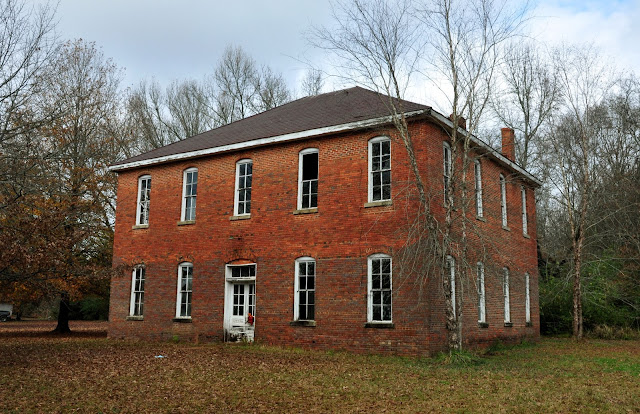Stores of the South - Old Salem School
At the turn of the 20th Century in Mississippi as well as the nation there was a push to better educational standards. In rural areas of Mississippi the norm was the one room school house as well as privately owned and run boarding schools. But more often than not due to the majority of families living on farms that needed every pair of able bodied hands, children were educated locally at a one room schoolhouse. In the second half of the 19th century school consolidation began to develop nationally as a result of efforts to increase educational efficiency and along with the advancement of motorized transport and the condition of state roads this became more feasible. I’ve already talked about this before in a prior post about the Clay County Agricultural School.
The other argument made for school consolidation was of course cost. It cost less per student to educate in the larger schools versus the one room school. It would allow for better organization, better quality of teachers, and of course more students meant more money to purchase better equipment. It also gave students a larger circle of acquaintance and made a wider variety of athletic activities possible. The consolidated school system slowly replaced the one room school house in all but the most remote of rural areas. After consolidation Noxubee County maintained 19 schools and established two school districts. There were 6 consolidated schools - Salem, Lynn Creek, Center Point, Cliftonville, Cooksville-Paulette, Mashulaville, and Brooksville. Today we’re going to cover Old Salem School.
The communities of Concord and Salem were interested in organizing a school and Mrs. Samual A. Adams was one of the early leaders with Mr. W. B. Jones the first superintendent. In 1904 land was purchased located 3.4 miles west of Macon on highway 14. The school was completed in 1914 and remained in use until 1939.
The building itself is 52 feet wide by 42 feet deep with brick walls being 1 foot thick. Plain brick chimneys rise on the east and west sides with the school with rooms being heated by wood burning stoves. As of 1916 the building was valued at $7,000 which doesn’t seem like much but in comparison the average household income in in Mississippi in 1916 was about $4,000 a year for the average worker. In today’s money that $7,000 is about $160,000.
The first floor had four large rooms divided by counter-weighted panels that could be raised and lowered to separate the 4 rooms into 8. The partitions were innovative and thoughtful for the time. Interior walls were plaster on wood lath above 3 foot high beadboard wainscoting. Wood trim, banisters, and stairs were all plain in design and the ceilings were press metal. The first floor was occupied by the grammar school students, grades 1-8 with 2 grades per room. The second floor was for the high school students grades 9-12. High school classes were math, science, history, and English. Often there were private music lessons available as well. The largest room on the east side had a stage that ran the length of the room and was used for study hall, music, chapel, and entertainment.
Children came from the surrounding communities first by two horse wagon and later by school bus. Each day started with the students lined up outside the school for the pledge of allegiance and daily prayer. Once a week chapel was held. Bible verses were read and songs such as America the Beautiful, My Country ‘Tis of Thee, and My Old Kentucky Home were sung. And always there was prayer. As for the classes, they were often crowded with three children sharing a desk made for two. The big rooms with their wood burning stoves were freezing in the winter and children learned fast to layer up their clothes to stay comfortable during the school day. Central heat and air were a ways off as was federally funded education. The county paid the teachers of which there were only 6 or 7. Four of the teachers taught the grammar school students, and two or three taught the upper grades. In an interview with Sallie Harper by the Mississippi Oral History Project she remembered a Mr.Mitchell who taught math and science and another teacher for english and history. You can listen to her short interview HERE. Books and supplies were paid for by the parents and grandparents of the pupils.
The community also chipped in by attending the many fundraisers put on by the school. One of their fundraisers was to have a stage play with the teachers and parents as actors. One such play had the two main characters played by two local sweethearts, Spence Guy and Alice Neil. According to the account by Herron Farrar Cockrell when they sang the title song My Wild Irish Rose there was not a dry eye in the building. Other plays and programs were produced for Thanksgiving, Christmas, Presidents Day, Valentines, and Easter. Each celebrated with an equal amount of enthusiasm by students and teachers alike. Another fundraiser, and probably the favorite was the “box supper.” The ladies of the community would prepare their very best supper, usually fried chicken with all the fixings, wrap it up in a beautifully decorated box, and each would be auctioned off with the proceeds going to the school. The catch was no one was supposed to know who made which box! The boxes were being auctioned off to the men of the community and of course each man wanted to purchase the meal prepared by his special lady. Each year though the men would find out who made which box. The married men would then have great fun running up the bid on the single ladies supper boxes much to the chagrin of their beaus. Along with the box suppers there were oyster suppers, ice cream socials, cake walks, and a Halloween carnival.
The school also participated in community projects as well to give back to the people of the community who helped support them. On Arbor Day each year every grade would plant a new tree. One of the water oaks in the front of the school was planted by Mrs. Cockrell and her 5th grade class in 1926. Another project, and one that could only be appreciated in a rural setting, was a dipping vat. This is usually a rectangular concrete structure set into the ground with a ramp in and out filled with water and chemicals to kill parasites. Animals like cows, horses, sheep, goats, dogs, and any other animal that needed to be treated for fleas, ticks, flies, etc. would be driven through the dipping vat. Each farmer had a certain day to drive his animals to the school for treatment. This all took place during the summer when school was out. Only in the country would this be a notable service to the community.
The last senior class to graduate from Salem School was in 1932 with the grammar school continuing to operate until 1936 or 1939 depending on the source. Today the building is significant as the largest and most sophisticated county public school building remaining in Noxubee County from the early 20th century. It was placed on the National Register of Historic Buildings in 1989. The school continues to stand as a product of some of the the earliest efforts of improving education in Noxubee County.
Last year was their 100th anniversary and the occasion was covered by local tv station WCBI and our local newspaper The Macon Beacon. You can read the WCBI article HERE and the Macon Beacon article HERE. Today the school is owned by the Salem Historical Society with future plans to renovate and maintain the building.
Resources:
Salem School by Herron Farrar Cockrell
from the Noxubee County Historical Trail by Gordon Hansen
Historical Notes of Noxubee County by John A. Tyson
Macon Beacon
WCBI.com - Making Old Salem New Again
Mississippi Oral History Project - Salem School
National Register for Historic Places Form - Salem School
Statistics of Income 1916









What a great story! You know I love stories that combine education and old buildings, but I always get a bit of a twinge when I think about "box suppers" and the ladies whose boxes did not fetch the same amount of money. I guess it was a lot like being picked last for the baseball team.
ReplyDeleteThank you! I thought about that too, but from the stories I've been told by locals I think there wasn't a bad meal to be had at the school.
DeleteLana, thanks for sharing this article in our recent thread on Facebook about the Clifttonville School. This was helpful. I’ve never heard about the dipping vat. I wish you were still writing these historical pieces. This one was so helpful!
ReplyDelete